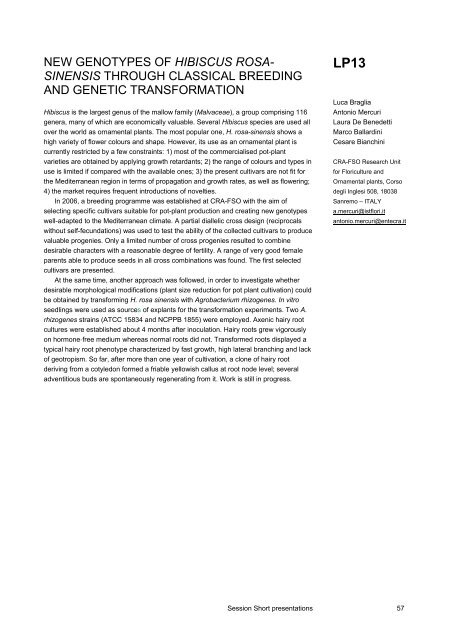XXIIIrd International Eucarpia symposium, Section Ornamentals ...
XXIIIrd International Eucarpia symposium, Section Ornamentals ...
XXIIIrd International Eucarpia symposium, Section Ornamentals ...
Create successful ePaper yourself
Turn your PDF publications into a flip-book with our unique Google optimized e-Paper software.
NEW GENOTYPES OF HIBISCUS ROSA-<br />
SINENSIS THROUGH CLASSICAL BREEDING<br />
AND GENETIC TRANSFORMATION<br />
Hibiscus is the largest genus of the mallow family (Malvaceae), a group comprising 116<br />
genera, many of which are economically valuable. Several Hibiscus species are used all<br />
over the world as ornamental plants. The most popular one, H. rosa-sinensis shows a<br />
high variety of flower colours and shape. However, its use as an ornamental plant is<br />
currently restricted by a few constraints: 1) most of the commercialised pot-plant<br />
varieties are obtained by applying growth retardants; 2) the range of colours and types in<br />
use is limited if compared with the available ones; 3) the present cultivars are not fit for<br />
the Mediterranean region in terms of propagation and growth rates, as well as flowering;<br />
4) the market requires frequent introductions of novelties.<br />
In 2006, a breeding programme was established at CRA-FSO with the aim of<br />
selecting specific cultivars suitable for pot-plant production and creating new genotypes<br />
well-adapted to the Mediterranean climate. A partial diallelic cross design (reciprocals<br />
without self-fecundations) was used to test the ability of the collected cultivars to produce<br />
valuable progenies. Only a limited number of cross progenies resulted to combine<br />
desirable characters with a reasonable degree of fertility. A range of very good female<br />
parents able to produce seeds in all cross combinations was found. The first selected<br />
cultivars are presented.<br />
At the same time, another approach was followed, in order to investigate whether<br />
desirable morphological modifications (plant size reduction for pot plant cultivation) could<br />
be obtained by transforming H. rosa sinensis with Agrobacterium rhizogenes. In vitro<br />
seedlings were used as sources of explants for the transformation experiments. Two A.<br />
rhizogenes strains (ATCC 15834 and NCPPB 1855) were employed. Axenic hairy root<br />
cultures were established about 4 months after inoculation. Hairy roots grew vigorously<br />
on hormone-free medium whereas normal roots did not. Transformed roots displayed a<br />
typical hairy root phenotype characterized by fast growth, high lateral branching and lack<br />
of geotropism. So far, after more than one year of cultivation, a clone of hairy root<br />
deriving from a cotyledon formed a friable yellowish callus at root node level; several<br />
adventitious buds are spontaneously regenerating from it. Work is still in progress.<br />
LP13<br />
Luca Braglia<br />
Antonio Mercuri<br />
Laura De Benedetti<br />
Marco Ballardini<br />
Cesare Bianchini<br />
CRA-FSO Research Unit<br />
for Floriculture and<br />
Ornamental plants, Corso<br />
degli Inglesi 508, 18038<br />
Sanremo – ITALY<br />
a.mercuri@istflori.it<br />
antonio.mercuri@entecra.it<br />
Session Short presentations 57














